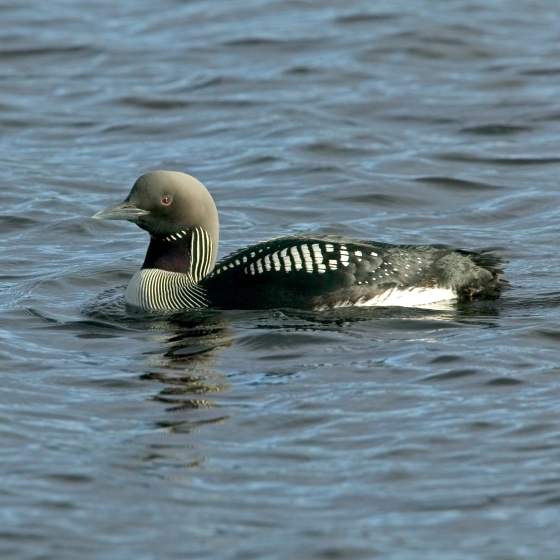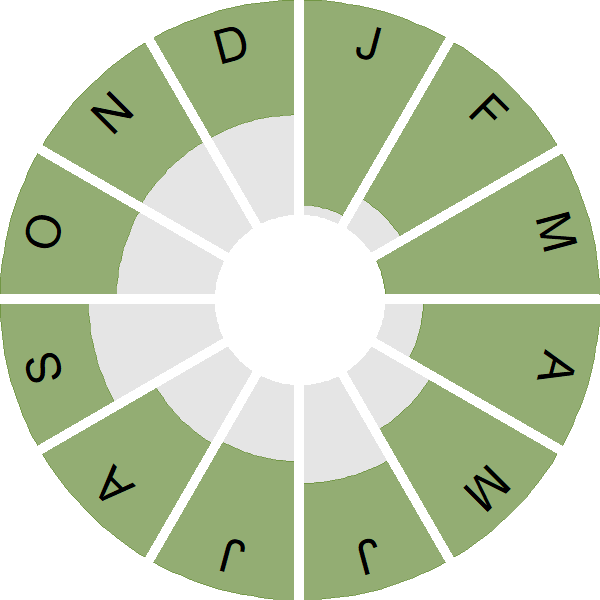Black-throated Diver

Introduction
Although only a monochrome bird, the Black-throated Diver in summer has exquisitely patterned black, white and grey plumage.
Breeding Black-throated Divers are found in north-west Scotland and the Outer Hebrides, inhabiting large lochs preferably with small islets for nesting. In winter Black-throated Divers are present in small numbers around much of Britain and Ireland's coastal waters.
Divers have their legs and feet set well back and find movement on land very cumbersome, so their nests are always close to water.

Key Stats
Identification
ID Videos
This section features BTO training videos headlining this species, or featuring it as a potential confusion species.
Winter Divers
Songs and Calls
Song:
Call:
Status and Trends
Conservation Status
Population Change
The Black-throated Diver has a small breeding population in Scotland, estimated at 215 pairs in 2006. This represents a slight increase of 16% since the previous survey in 1994, with increases occurring throughout the Scottish range (Eaton et al. 2007). A 10% range expansion has also occurred between 1988–91 and 2008–11 (Balmer et al. 2013). An assessment of environmental variables suggests there are many lakes within the range of the species that are suitable but vacant but there is insufficient historical data to assess the medium to long-term population trend (Jackson 2005) and it is therefore unclear whether the population has always been small.
Distribution
Black-throated Divers are present round much of the coast of Britain in winter, though are virtually absent from Shetland and are scarce around northeast Scotland and Wales. The breeding distribution of Black-throated Divers is confined mainly to north and west Scotland and the Outer Hebrides.
Occupied 10-km squares in UK
or view it on Bird Atlas Mapstore.
or view it on Bird Atlas Mapstore.
European Distribution Map
Distribution Change
Black-throated Diver's British breeding range has expanded 10% since the 1988–91 Breeding Atlas. Gains are concentrated in the eastern and southern parts of the range, though many of these new records refer to single birds or pairs on suitable lochs, rather than confirmed breeding events.
Change in occupied 10-km squares in the UK
or view it on Bird Atlas Mapstore.
or view it on Bird Atlas Mapstore.
Seasonality
Black-throated Divers are recorded year-round, though scarce, being reported on only around 1% of complete lists.
Weekly pattern of occurrence
The graph shows when the species is present in the UK, with taller bars indicating a higher likelihood of encountering the species in appropriate regions and habitats.

Movement
Britain & Ireland movement
European movements
EuroBirdPortal uses birdwatcher's records, such as those logged in BirdTrack to map the flows of birds as they arrive and depart Europe. See maps for this species here.
The Eurasian-African Migration Atlas shows movements of individual birds ringed or recovered in Europe. See maps for this species here.
Biology
Productivity and Nesting
Nesting timing
Egg measurements
Clutch Size
Survival and Longevity
Survival is shown as the proportion of birds surviving from one year to the next and is derived from bird ringing data. It can also be used to estimate how long birds typically live.
lifespan
Survival of adults
Biometrics
Wing length and body weights are from live birds (source).
Ring Size
Classification, names and codes
Classification and Codes
- Order: Gaviiformes
- Family: Gaviidae
- Scientific name: Gavia arctica
- Authority: Linnaeus, 1758
- BTO 2-letter code: BV
- BTO 5-letter code: BLTDI
- Euring code number: 30
Alternate species names
- Catalan: calàbria agulla
- Czech: potáplice severní
- Danish: Sortstrubet Lom
- Dutch: Parelduiker
- Estonian: järvekaur
- Finnish: kuikka
- French: Plongeon arctique
- Gaelic: Learga-dhubh
- German: Prachttaucher
- Hungarian: sarki búvár
- Icelandic: Glitbrúsi
- Irish: Lóma Artach
- Italian: Strolaga mezzana
- Latvian: melnkakla gargale
- Lithuanian: juodakaklis naras
- Norwegian: Storlom
- Polish: nur czarnoszyi
- Portuguese: mobelha-de-garganta-preta
- Slovak: potáplica stredná
- Slovenian: polarni slapnik
- Spanish: Colimbo ártico
- Swedish: storlom
- Welsh: Trochydd Gyddfddu
Research
Causes of Change and Solutions
Causes of change
Analysis by Mudge & Talbot (1993) found that breeding productivity was very low and they tentatively suggested that it was too low to maintain a stable population at the time; most failures were attributed to flooding and predation. The provision of rafts to provide safe breeding sites improved breeding productivity by an estimated 44% (Hancock 2000) and hence may have contributed towards the observed recent population increases.

